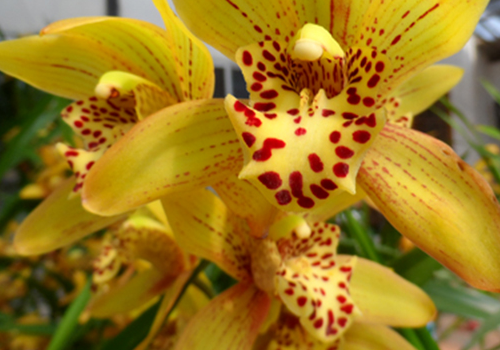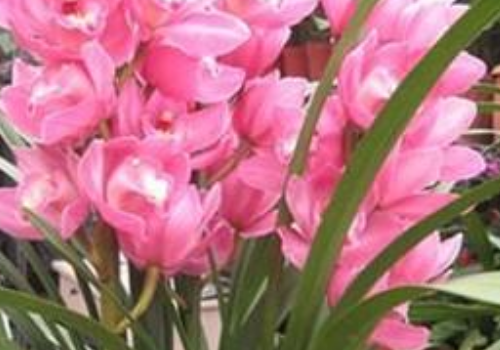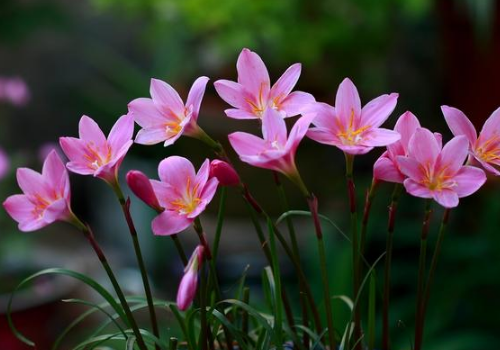How to compound flowers and rotten roots of Cymbidium
Cymbidium, I believe many people have seen it, it is very beautiful when it blossoms. How can Cymbidium reblossom? What about the rotten roots?
How to rebloom Cymbidium:
1. Ensure sufficient light
2. the temperature should not be too high in winter.
The best growth temperature is between 10 and 25 degrees, but the winter temperature should not be too high, especially the indoor temperature in the north, which is comparable to the summer temperature, which is very disadvantageous to its reflowering, and the temperature at night in winter can be maintained at about 10 degrees.
3. Watering should be carried out after normal watering.
In summer, you can water 2 to 3 times a day, and in other seasons, you can water once every 3 to 4 days, or judge whether it should be watered according to the condition of the soil. If the soil layer is slightly dry, it should be watered immediately, especially during the growing period. Watering should be fully watered at once. In addition to normal watering, it is also necessary to sprinkle the leaves and surrounding areas frequently, preferably in a foggy shape, so that the air is humidified and the leaves are not yellowed.
4. Skills of fertilizer application
Normal fertilization should be applied during the growing period, but attention should be paid to the fact that the fertilizer is not too thick, rather light than thick. Fertilization should be carried out before flowering, and fertilization should not be suspended during flowering and summer.
After the above conditions are necessary, reflowering is not a difficult task. In fact, it is easier to reproduce flowers if they are directly exposed, but if it is not convenient to raise them, try to choose places with good ventilation and plenty of sunshine for breeding.

What about the rotten roots of Cymbidium:
1. Root cutting
If the rotten roots of Cymbidium grown at home occur, first of all, we should cut off the rotten roots and withered leaves, and remove the sundries next to the rotten roots, so as to avoid the spread of festering parts and deepen the disease of the orchids.
2. Disinfection
Disinfect Cymbidium by disinfecting it with 1% potassium permanganate, soaking it for two hours, then washing it, and putting it in the sun for a period of time. Then replace it with new plant materials, which can be mixed with water moss, bark, vermiculite, rotten leaf soil and peat soil.
3. Change the basin
It is recommended to change the cymbidium to a well-ventilated, deeper basin, where some wood or bricks can be put at the bottom to increase ventilation. Often spray water around the leaves every day, twice, often open the window for ventilation, it is OK, I believe the orchid will get better
All right, this is the end of the introduction of the solution to the rotten roots of Cymbidium, all of you understand.
[Cymbidium grandiflorum rotten root] how to do and save the rotten root of Cymbidium grandiflora
Cymbidium is a kind of plant that can keep evergreen all the year round, which is very suitable for indoor culture. Cymbidium is an axial growing orchid. When choosing a flowerpot, you need to choose a long tube-shaped pot. And the culture environment must be well ventilated, and charcoal should be added to the bottom of the flowerpot to facilitate drainage. The main purpose of this is to prevent the roots of Cymbidium from rotting. Because poor drainage or poor ventilation will lead to the root rot of Cymbidium, if the root of Cymbidium is half rotten, then Cymbidium can basically be judged to be finished. Here's what we should do if we encounter the rotten roots of Cymbidium.
What about the rotten roots of Cymbidium? 1. Cut off the rotten parts
Pour out the cymbidium and leave it in a cool, dry and ventilated place for one or two days. All the rotten roots that have blackened will be cut off, and the plants that lean against the rotten roots will be removed, leaving no hidden trouble. Be sure to water less, and less when watering nutrition and rooting water. In case it happens again.
2. Strictly disinfect orchid plants and plant materials.
Soak the orchid plant in 1 ‰ potassium permanganate solution for 2 hours, rinse with clean water, and dry in the sun for 2 hours. The new plant materials I use are: catalpa bark 50%, broken brick particles 20%, honeycomb cinder 20%, rotten pine needle 10%. After washing the first three kinds of clean water, soak and disinfect them with boiling water. Pine needles are exposed to the sun and sprayed with 2% topiramate solution for disinfection.
3. Switch to mud basin cultivation.
Cymbidium with rotten roots should not only have a certain degree of humidity, but also not be too wet. This requires good permeability. I chose two mud basins. In order to increase the air flow, I enlarged the water seepage hole at the bottom of the basin and put several long wooden strips on the bottom of the basin to increase the air permeability. Plant the sterilized Cymbidium in a basin, spread a layer of bark of 2-3 cm in diameter and broken bricks the size of walnut at the bottom, fill the middle with a medium-sized plant mixture, and top with the smallest one.
4. Daily management
After watering the roots of Cymbidium, Cymbidium was cured in low light for more than 10 days, sprayed twice a day, and placed on the south windowsill after half a month. About 1 month later, the plant grew new roots, and 3 months later, purplish red new buds grew on the pseudobulbs. It is not allowed to apply fertilizer before growing new roots, and only light fertilizer can be applied after growing new roots and new buds. 1-2 ‰ compound fertilizer is added to the water for raising goldfish.
In summer, the high temperature put a shallow plastic pot under Cymbidium, which filled with water, increased humidity, sprayed around the flowerpot every morning, middle and evening, and opened windows for ventilation to make it through the summer smoothly. When carbendazim or topiramate was sprayed every half a month, there were almost no diseases and insect pests.
In November, two fat flower buds grew on the pseudobulbs of the newborn seedlings closest to the windowsill. At this time, phosphate fertilizer was added every 10 days, and foliar buds were sprayed with 2 ‰ potassium dihydrogen phosphate, and all the new leaf buds were removed to concentrate nutrients on the growth of flower buds.
What about the rotten roots of Cymbidium, the treatment of the rotten roots of Cymbidium / change the pot in time
Cymbidium, a hybrid variety of orchids, has large flowers and rich colors, so it is deeply loved by flower friends. In life, many people raise Cymbidium, but in the process of breeding, they often encounter the phenomenon of rotten roots. What about the rotten roots of Cymbidium? Next, the editor will bring you several treatments for the rotten roots of Cymbidium.
First, what about the rotten roots of Cymbidium? find the cause
After flowering, Cymbidium is very elegant and magnificent with bright colors. Many of the flower friends who raise it are novice. For various reasons, they often feed the roots of Cymbidium. What about the rotten roots of Cymbidium? At this time, do not worry, we should calmly look for the cause, the following are three kinds of Cymbidium rotten root causes and treatment methods, let's move on.
Second, the reasons for the rotting roots of Cymbidium.
1. Soil discomfort
There are many reasons for the rotten roots of Cymbidium, we should first think of soil factors. In the cultivation method of Cymbidium, it has been said that it needs loose soil, so once the soil is not loose and the root permeability is poor, it is easy to cause anoxic rot of the root.
2. Overwatering
Cymbidium likes a moist environment, but it has fleshy roots and can store water. Therefore, too much watering will cause stagnant water in the basin soil and poor breathing at the roots, which can easily lead to rotten roots of Cymbidium, and then there will be symptoms of yellowing of Cymbidium leaves.
3. Improper fertilization
During the growth of Cymbidium, we have to fertilize it properly, but this is difficult to control. Many novices will fertilize too much or too much, resulting in fertilizer damage, resulting in rotting roots. Generally speaking, there are only three reasons for the rotten roots of Cymbidium. Next, let's take a look at the treatment methods.
Third, the treatment of rotten roots of Cymbidium.
1. Root cutting
If the roots of Cymbidium grown at home are rotten, don't worry, first pull out the whole plant, and then cut off its rotten roots and withered leaves. Note that the sundries next to the rotten roots should also be cut off to avoid the spread of festering parts and deepen the disease of Cymbidium.
2. Disinfection
After cutting off the rotten part, we need to disinfect the plant. Specific operation: Cymbidium is disinfected with 1% potassium permanganate, soaked for two hours and then washed, put in the sun for a period of time. After that, it can be replaced with a new soil, and the editor recommends a mixture of water moss, bark, vermiculite, rotten leaf soil and peat soil.
3. Change the basin
After completing the above steps, there is only the last step left in the treatment of the rotten roots of Cymbidium, and that is to change the basin. Change the treated Cymbidium to a well-ventilated, deeper basin, where you can put some wood or bricks at the bottom to increase ventilation. Then often spray water around the leaves every day, and often open windows for ventilation, I believe that soon your plant will return to health.
Through the above introduction, I believe that if you encounter the symptoms of rotten roots again, you should know how to do it! Generally speaking, Cymbidium is not difficult to raise, as long as everyone is more careful, rotten roots will not appear. Of course, there is no hurry, according to the above method of treatment. With regard to the causes and treatment methods of the rotten roots of Cymbidium, the editor has introduced this, hoping to give you some help.
- Prev

What is the reason for the yellowing of the leaf core of Cymbidium?
Many people are growing Cymbidium, but some of them will turn yellow. What is the reason why the leaf core of Cymbidium turns yellow? What shall I do? one。 Yellow Cymbidium caused by poor light is a sunny plant, but it can't stand strong light. Generally, astigmatism is the best, even if the light is too weak.
- Next

How to raise leek lotus? can you keep it indoors?
Leek lotus leaves green, flowering, the flowers are pink, color matching is very eye-catching, beautiful and chic, let you feel beautiful every day. How to raise leek lotus? Can you put it indoors: how to raise leek lotus: 1. Main points of soil culture: fertile sandy loam is better for cultivation.
Related
- Fuxing push coffee new agricultural production and marketing class: lack of small-scale processing plants
- Jujube rice field leisure farm deep ploughing Yilan for five years to create a space for organic food and play
- Nongyu Farm-A trial of organic papaya for brave women with advanced technology
- Four points for attention in the prevention and control of diseases and insect pests of edible fungi
- How to add nutrient solution to Edible Fungi
- Is there any good way to control edible fungus mites?
- Open Inoculation Technology of Edible Fungi
- Is there any clever way to use fertilizer for edible fungus in winter?
- What agents are used to kill the pathogens of edible fungi in the mushroom shed?
- Rapid drying of Edible Fungi

